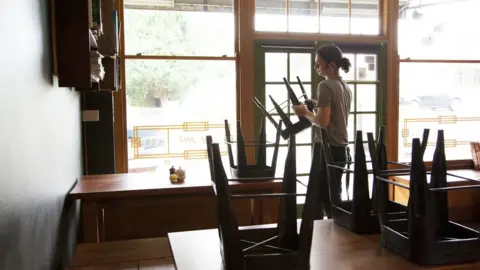Unemployment rate in Wales rises sharply to 3.8%
 Getty Images
Getty ImagesWales' unemployment rate rose significantly between June and August to 3.8%, compared with 4.5% for the whole of the UK, according to the latest figures.
There were 15,000 more people counted as jobless compared with March to May.
The number of people employed in the three months to August was 37,000 fewer than the previous quarter.
Workers furloughed under the Treasury's scheme to support jobs through the Covid-19 pandemic count as employed.
During August the furlough scheme began to reduce support paid to employers to pay workers.
Wales' unemployment is at the same level as September 2019, but it rose at twice the UK rate in the last quarter.
The rate of working age people deemed "economically inactive" has climbed to 24.4% in Wales - the UK rate is 20.8%.
These are people not looking for work, normally because they are full-time carers or students, are on long-term sick or have taken early retirement.
The Office for National Statistics survey suggested there were 36,000 more people in this bracket in Wales compared with the same period last year. It is the second highest rate of economic inactivity in the UK after Northern Ireland.
The UK unemployment rate stands at its highest level in over three years as the pandemic continues to hit jobs.
The figures suggested there were 57,000 people in Wales who were unemployed, meaning they were out of work and looking for a job. Between March and May it was 42,000.
There were 1,452,000 people in work from June to August and 466,000 people who were deemed economically inactive.
What about furlough?
These figures do not include people who were furloughed.
In June, 316,500 employees in Wales were paid 80% of their salaries under the UK government's furlough scheme, figures from the Treasury showed.
The support provided to employers for wages began to reduce in August.
Furlough - which paid up to 80% of workers' wages - will end completely on 31 October and is being replaced with the Job Support Scheme.

Earlier in the summer BBC Wales spoke to Owen Davies from Pill in Newport.
He lives with his 31-year-old partner Sarah Eddolls, who has asthma, and his parents, who both have health problems.
When Covid-19 hit, they began to shield and Owen and Sarah decided to quit their jobs to keep the family safe.
She had been working for an agency on a zero-hours contract, taking the food trolley around the wards of the Royal Gwent Hospital in Newport.
He had been working for an agency as a call logger, supporting transport and sending work on to nurses and porters.
Six months on, Owen has managed to get a job, working night shifts at Amazon's regional distribution centre a few miles away, but Sarah is still unemployed. They both had been claiming Universal Credit but now that he is earning, she is no longer eligible and has no income herself.
She said she spends all day applying for "anything and everything", with no success so far - and companies have told her they are inundated with applications.
Christine Griffiths, operations manager at Vibe Recruit, which has offices in Cwmbran, Bridgend, Caerphilly and Swansea, said she had seen a "dramatic rise in the amount of people who are applying for the roles that we advertise".
"Since the national lockdown in March, we have seen a shift in the type of contracts that are being offered by our clients. Whilst the permanent recruitment market has slowed down, the temporary market is thriving, with clients preferring the flexibility that hiring a candidate on a temporary basis can bring."
More optimistically, she said there had been a "clear sign" of the permanent recruitment market picking back up again.

Analysis by BBC Wales Economics Correspondent Sarah Dickins
Economic trends, such as an increase in unemployment, tend to affect Wales later than the UK as a whole.
That is reflected in the fact these jobless figures are the worst the UK has seen for three years, but Wales experienced the same level of unemployment as recently as September 2019.
That makes the steep rise in unemployment in Wales in the three months to August even more concerning.
Welsh unemployment grew at twice the speed of that seen across the UK, even though as a proportion of the population, fewer Welsh workers are unemployed at the moment.
More worryingly still, the reduction in the number of jobs in Wales between June and August, compared with the previous three months, was five times greater than the decline in employment levels across the UK.
Meanwhile, the rate of working-age people who are not in the jobs market at all in Wales, because they are economically inactive, has gone up 0.7 percentage points to 24.4% - the UK as a whole has remained steady at 20.8%.
